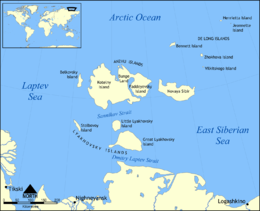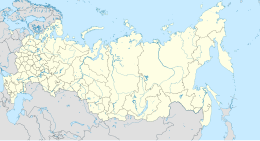New Siberian Islands
| Native name: Новосиби́рские острова | |
|---|---|

Location of the New Siberian Islands
|
|
| New Siberian Islands (Russia) | |
| Geography | |
| Location | between the Laptev Sea and East Siberian Sea |
| Coordinates | 75°16′N 145°15′E / 75.267°N 145.250°ECoordinates: 75°16′N 145°15′E / 75.267°N 145.250°E |
| Archipelago | New Siberian Islands |
| Area | 29,900 km2 (11,500 sq mi) |
| Highest elevation | 374 m (1,227 ft) |
| Highest point | Malakatyn Tas |
| Administration | |
|
Russia
|
|
| Country | Russian Federation |
| Federal subject | Sakha Republic (Yakutia) |
| Demographics | |
| Population | Uninhabited |
The New Siberian Islands (Russian: Новосиби́рские острова, Novosibirskiye Ostrova) are an archipelago in the Extreme North of Russia, to the North of the East Siberian coast between the Laptev Sea and the East Siberian Sea north of the Sakha (Yakutia) Republic.
The first news about the existence of the New Siberian Islands was brought by a Cossack, Yakov Permyakov, in the beginning of the 18th century. In 1712, a Cossack unit led by M. Vagin reached the Great Lyakhovsky Island. At the beginning of the 19th century, the islands were further explored by Yakov Sannikov, Matvei Gedenschtrom and others.
In 1809–10 Yakov Sannikov and Matvei Gedenschtrom went to the New Siberian Islands on a cartographic expedition. Yakov Sannikov reported the sighting of a "new land" north of Kotelny in 1811. This became the myth of Zemlya Sannikova or Sannikov Land.
In 1886 Eduard von Toll, during his first visit to the New Siberian Islands, thought that he had seen an unknown land north of Kotelny Island. He guessed that this was the so-called Zemlya Sannikova.
Polar explorer and scientist Eduard Toll paid a further visit to this island group in the spring of 1892, accompanied only by one Cossack and three natives. He traveled over the ice in sleds drawn by dogs and reached the south coast of Great Lyakhovsky Island. Along the southern coast of this island he found well-preserved bones, ivory, peat, wood, and even a tree within 40-meter (130-foot) high sea cliffs that expose sediments. These sediments are cemented by permafrost and have accumulated periodically over the last 200,000 years.
...
Wikipedia

